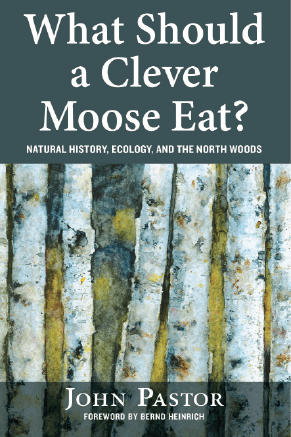In an excerpt from John Pastor’s new book, What Should a Clever Moose Eat? Natural History, Ecology, and the North Woods, the author examines the impact of climate change on the North Woods and the personal responsibility that comes with it. Copyright © 2016 John Pastor. Reproduced by permission of Island Press, Washington, D.C.
By John Pastor
The North Woods often seem eternal to people who live or travel there. This is especially so in the old growth forests of the Quetico-Superior and Adirondack Wildernesses. In 1954, William Chapman White wrote in his classic book Adirondack Country, “As a man tramples the woods to the lake, he knows he will find pines and lilies, blue heron and golden shiners, shadows on the rocks, and the glint of light on the waters, just as they were in the summer of 1354, as they will be in 2054 and beyond.”
Yes, we might see more or less the same scene if we time-traveled back to 1354, but it is an open question whether we will be able to see these forests in 2054. In 1354, the carbon dioxide concentration of the atmosphere was a mere 280 parts per million. Today, the carbon dioxide concentration of the atmosphere is 400 parts per million and it may be well above 450 parts per million by 2054. Carbon dioxide traps heat. As its atmospheric concentration is increasing, the temperature of the earth is rising rapidly, especially in northern regions.
At the end of the Ice Ages, the North Woods was not an intact biome sitting south of the ice sheet. Rather, starting 6,000 years ago it gradually assembled itself as the species we know today invaded the barren landscape, one by one and from different directions, as the ice sheet retreated. With further warming, the North Woods will not simply shift northward but instead it will very likely disassemble as species contract their southern and western boundaries at different rates and in different directions and beginning at different times. New species combinations will replace the North Woods in its current location.
As the earth warms, spruce and fir will invade the regions that are currently tundra. Much of the year, the tundra is now a white expanse of snow and a nearly perfect reflector of the sun’s radiation. This white expanse cools the earth. In contrast, the dark conifers to the south of the tundra absorb sunlight and convert it into heat. As the dark conifers invade the white tundra, less sunlight will be reflected and more of the sun’s warmth will be absorbed. The energy balance of the earth will then shift toward warmer falls, winters, and springs. Warming in northern latitudes will not simply produce a shift in these biomes; the shift in species’ ranges will also feed back and exacerbate the warming.
Most computer models predict the near disappearance of the North Woods in its current location if temperatures increase as little as 3 or 4 degrees F and especially if the warming is accompanied by droughts in midcontinent areas. These predictions are already coming to pass, as spruce and fir growth are decreasing and maple growth is increasing in northern Minnesota. If we continue to warm the climate as we have been doing, the different migrations of species may cause the North Woods to become confined to isolated pockets in Canada sometime during my grandchildren’s, and certainly during my great-grandchildren’s, lifetimes.
So much of how we define ourselves as a people depends on the natural history of the landscapes we live in and the organisms we live with. Arizonans are the people of the Sonoran Desert; Vermonters are the people of sugar maples and maple syrup; Minnesotans are the people of big pines, wolves, moose, and the wails of loons. Who will we be if we lose the landscapes and organisms that define us? What will our grandchildren and great-grandchildren think of us when they learn that, by burning fossil fuels, we deprived them of the opportunity to also be the people of white pine, moose, and loons, even though we knew what the consequences would be? Can any of us look our grandchildren and great-grandchildren in the eye and try to explain this without shame?

To preserve the North Woods for the future, we will need to preserve the climate of the entire planet as well as current wilderness areas such as Quetico-Superior. If we do not, new assemblages of species will form and the North Woods as an intact ecosystem will probably almost, if not entirely, disappear. We are on the cusp of whether we want to try to stop the worst of this.
We are now responsible for the future of the North Woods.
To order Pastor’s book or read more essays about natural history, ecology, and the North Woods, please visit http://www.theclevermoose.com/. Use the code 4moose when ordering the book from Island Press and receive a 20% discount (2016).

